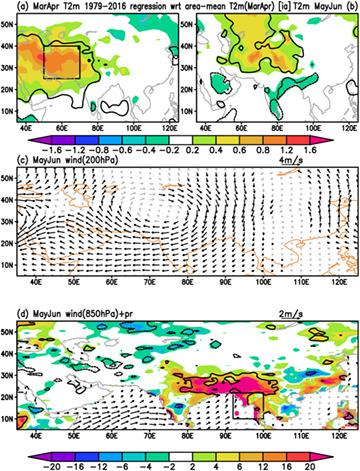当前位置:
X-MOL 学术
›
Int. J. Climatol.
›
论文详情
Our official English website, www.x-mol.net, welcomes your feedback! (Note: you will need to create a separate account there.)
Land surface signal of the Indochina Peninsular precipitation variability during the early rainy season
International Journal of Climatology ( IF 3.9 ) Pub Date : 2020-12-27 , DOI: 10.1002/joc.6989 Zhibiao Wang 1 , Renguang Wu 1, 2, 3
International Journal of Climatology ( IF 3.9 ) Pub Date : 2020-12-27 , DOI: 10.1002/joc.6989 Zhibiao Wang 1 , Renguang Wu 1, 2, 3
Affiliation

|
The precipitation variability is subject to impacts of both ocean and land surface condition changes. The present study investigates the role of land surface condition in the interannual variation of the early rainy season (May–June) precipitation over the Indochina Peninsula. A precursory signal is identified in surface air temperature (SAT) during March–April over central Asia after the late 1970s. The air temperature anomalies extend to middle troposphere and persist to early summer (May–June) and modulate the land‐sea thermal contrast and lower‐level and upper‐level winds over the North Indian Ocean and thus affect the early rainy season precipitation over the Indochina Peninsula. The maintenance of SAT anomalies over central Asia is related to that of surface heat flux anomalies that in turn is attributed to the persisting atmospheric wind anomalies. The precursory signal is weak before the late 1970s due to the lack of persisting atmospheric wind anomalies. The interdecadal change in the persistence of central Asian SAT anomalies is associated with a difference in the distribution of the North Atlantic sea surface temperature (SST) anomalies. After the late 1970s, the North Atlantic SST anomalies with a southwest‐northeast distribution excite a wave train that extends from the North Atlantic to central Asia during May–June. Before the late 1970s, the wave train associated the North Atlantic SST anomalies with a south–north distribution is confined to the North Atlantic region.
中文翻译:

雨季初期印度支那半岛降水变化的地表信号
降水的变化性受海洋和陆地表面状况变化的影响。本研究调查了印度支那半岛上雨季(5月至6月)早期降水的年际变化中地表条件的作用。在1970年代后期之后的中亚3月至4月期间,地面空气温度(SAT)中识别出一个先兆信号。气温异常延伸到对流层中部,持续到夏初(5月至6月),并调节了北印度洋上的陆海热反差和低空和高空风,从而影响了印度洋早期的雨季降水。印度支那半岛。中亚地区SAT异常的维持与地表热通量异常有关,而后者又归因于持续存在的大气风异常。由于缺乏持续的大气风异常,前兆信号在1970年代后期之前微弱。中亚SAT异常持续时间的年代际变化与北大西洋海表温度(SST)异常分布的差异有关。1970年代后期以来,北大西洋SST异常具有西南-东北分布,激发了从5月到6月从北大西洋延伸到中亚的波列。在1970年代末期之前,与北大西洋海温异常和南北分布相关的波列仅限于北大西洋地区。由于缺乏持续的大气风异常,前兆信号在1970年代后期之前微弱。中亚SAT异常持续时间的年代际变化与北大西洋海表温度(SST)异常分布的差异有关。1970年代后期以来,北大西洋SST异常具有西南-东北分布,激发了从5月到6月从北大西洋延伸到中亚的波列。在1970年代后期之前,与北大西洋海温异常和南北分布相关的波列仅限于北大西洋地区。由于缺乏持续的大气风异常,前兆信号在1970年代后期之前微弱。中亚SAT异常持续时间的年代际变化与北大西洋海表温度(SST)异常分布的差异有关。1970年代后期以来,北大西洋SST异常具有西南-东北分布,激发了从5月到6月从北大西洋延伸到中亚的波列。在1970年代后期之前,与北大西洋海温异常和南北分布相关的波列仅限于北大西洋地区。中亚SAT异常持续时间的年代际变化与北大西洋海表温度(SST)异常分布的差异有关。1970年代后期以来,北大西洋SST异常具有西南-东北分布,激发了从5月到6月从北大西洋延伸到中亚的波列。在1970年代后期之前,与北大西洋海温异常和南北分布相关的波列仅限于北大西洋地区。中亚SAT异常持续时间的年代际变化与北大西洋海表温度(SST)异常分布的差异有关。1970年代后期以来,北大西洋SST异常具有西南-东北分布,激发了从5月到6月从北大西洋延伸到中亚的波列。在1970年代后期之前,与北大西洋海温异常和南北分布相关的波列仅限于北大西洋地区。
更新日期:2020-12-27
中文翻译:

雨季初期印度支那半岛降水变化的地表信号
降水的变化性受海洋和陆地表面状况变化的影响。本研究调查了印度支那半岛上雨季(5月至6月)早期降水的年际变化中地表条件的作用。在1970年代后期之后的中亚3月至4月期间,地面空气温度(SAT)中识别出一个先兆信号。气温异常延伸到对流层中部,持续到夏初(5月至6月),并调节了北印度洋上的陆海热反差和低空和高空风,从而影响了印度洋早期的雨季降水。印度支那半岛。中亚地区SAT异常的维持与地表热通量异常有关,而后者又归因于持续存在的大气风异常。由于缺乏持续的大气风异常,前兆信号在1970年代后期之前微弱。中亚SAT异常持续时间的年代际变化与北大西洋海表温度(SST)异常分布的差异有关。1970年代后期以来,北大西洋SST异常具有西南-东北分布,激发了从5月到6月从北大西洋延伸到中亚的波列。在1970年代末期之前,与北大西洋海温异常和南北分布相关的波列仅限于北大西洋地区。由于缺乏持续的大气风异常,前兆信号在1970年代后期之前微弱。中亚SAT异常持续时间的年代际变化与北大西洋海表温度(SST)异常分布的差异有关。1970年代后期以来,北大西洋SST异常具有西南-东北分布,激发了从5月到6月从北大西洋延伸到中亚的波列。在1970年代后期之前,与北大西洋海温异常和南北分布相关的波列仅限于北大西洋地区。由于缺乏持续的大气风异常,前兆信号在1970年代后期之前微弱。中亚SAT异常持续时间的年代际变化与北大西洋海表温度(SST)异常分布的差异有关。1970年代后期以来,北大西洋SST异常具有西南-东北分布,激发了从5月到6月从北大西洋延伸到中亚的波列。在1970年代后期之前,与北大西洋海温异常和南北分布相关的波列仅限于北大西洋地区。中亚SAT异常持续时间的年代际变化与北大西洋海表温度(SST)异常分布的差异有关。1970年代后期以来,北大西洋SST异常具有西南-东北分布,激发了从5月到6月从北大西洋延伸到中亚的波列。在1970年代后期之前,与北大西洋海温异常和南北分布相关的波列仅限于北大西洋地区。中亚SAT异常持续时间的年代际变化与北大西洋海表温度(SST)异常分布的差异有关。1970年代后期以来,北大西洋SST异常具有西南-东北分布,激发了从5月到6月从北大西洋延伸到中亚的波列。在1970年代后期之前,与北大西洋海温异常和南北分布相关的波列仅限于北大西洋地区。



























 京公网安备 11010802027423号
京公网安备 11010802027423号